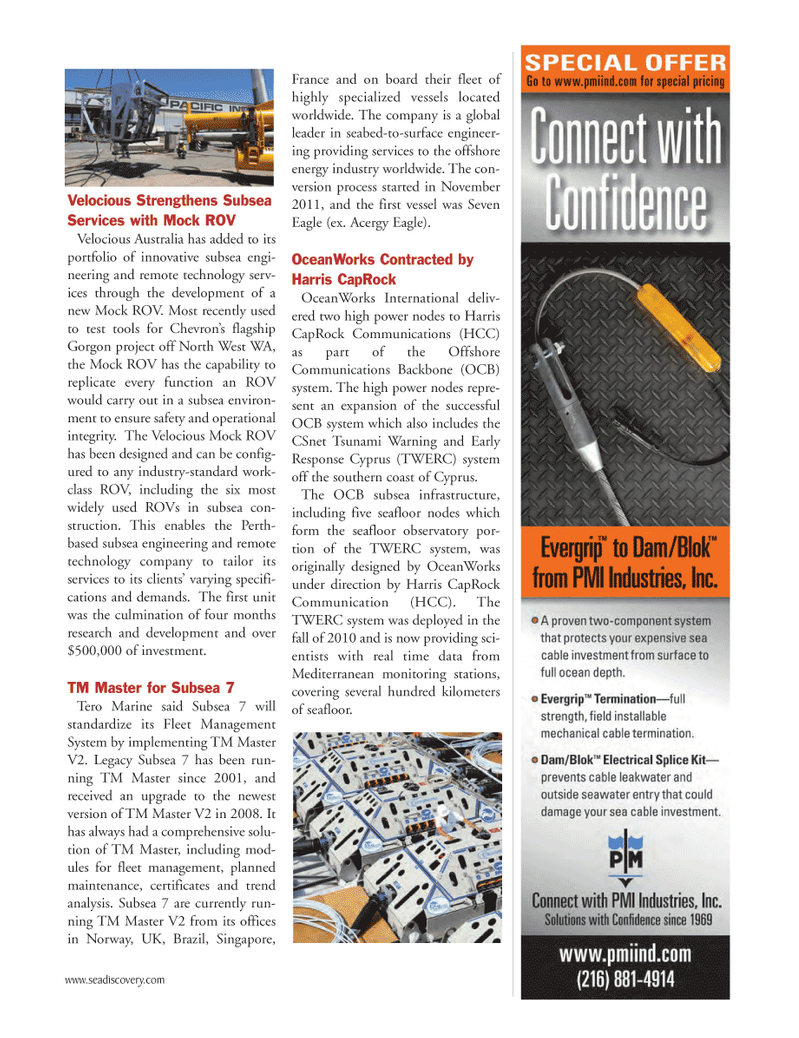
Page 81: of Marine Technology Magazine (March 2012)
Subsea Vehicle Report – Unmanned Underwater Systems
Read this page in Pdf, Flash or Html5 edition of March 2012 Marine Technology Magazine
www.seadiscovery.com Velocious Strengthens Subsea Services with Mock ROV Velocious Australia has added to its portfolio of innovative subsea engi- neering and remote technology serv- ices through the development of a new Mock ROV. Most recently used to test tools for Chevron?s flagship Gorgon project off North West WA, the Mock ROV has the capability to replicate every function an ROV would carry out in a subsea environ- ment to ensure safety and operational integrity. The Velocious Mock ROV has been designed and can be config-ured to any industry-standard work- class ROV, including the six most widely used ROVs in subsea con- struction. This enables the Perth- based subsea engineering and remote technology company to tailor itsservices to its clients? varying specifi- cations and demands. The first unit was the culmination of four monthsresearch and development and over $500,000 of investment. TM Master for Subsea 7Tero Marine said Subsea 7 will standardize its Fleet Management System by implementing TM Master V2. Legacy Subsea 7 has been run- ning TM Master since 2001, and received an upgrade to the newest version of TM Master V2 in 2008. It has always had a comprehensive solu- tion of TM Master, including mod- ules for fleet management, plannedmaintenance, certificates and trend analysis. Subsea 7 are currently run- ning TM Master V2 from its offices in Norway, UK, Brazil, Singapore, France and on board their fleet of highly specialized vessels located worldwide. The company is a global leader in seabed-to-surface engineer- ing providing services to the offshore energy industry worldwide. The con- version process started in November 2011, and the first vessel was Seven Eagle (ex. Acergy Eagle). OceanWorks Contracted by Harris CapRock OceanWorks International deliv- ered two high power nodes to Harris CapRock Communications (HCC) as part of the Offshore Communications Backbone (OCB) system. The high power nodes repre- sent an expansion of the successfulOCB system which also includes theCSnet Tsunami Warning and Early Response Cyprus (TWERC) system off the southern coast of Cyprus. The OCB subsea infrastructure, including five seafloor nodes which form the seafloor observatory por- tion of the TWERC system, was originally designed by OceanWorks under direction by Harris CapRock Communication (HCC). The TWERC system was deployed in the fall of 2010 and is now providing sci- entists with real time data from Mediterranean monitoring stations, covering several hundred kilometers of seafloor. MTR#2 (66-81):MTR Layouts 2/22/2012 10:20 AM Page 81

 80
80

 82
82
